belt FIAT DUCATO BASE CAMPER 2016 Owner handbook (in English)
[x] Cancel search | Manufacturer: FIAT, Model Year: 2016, Model line: DUCATO BASE CAMPER, Model: FIAT DUCATO BASE CAMPER 2016Pages: 387, PDF Size: 20.76 MB
Page 167 of 387

WARNING
107) The pretensioner may be used
only once. After it is triggered,
have it replaced at a Fiat
Dealership.
108) The belt must not be twisted.
The upper part must pass over
the shoulder and cross the chest
diagonally. The lower part must
adhere to the pelvis (as shown in
fig. 157) rather than the abdomen
of the passenger. Never use
devices (clips, clamps, etc.) that
hold the seat belt away from your
body.
109) For maximum protection, keep
the backrest upright, lean back
into it and make sure the seat belt
fits closely across your chest
and pelvis. Always fasten the seat
belts on both the front and the
rear seats! Travelling without
wearing seat belts will increase
the risk of serious injury and even
death in the event of an accident.110) Removing or otherwise
tampering with seat belt and
pretensioner components is
strictly prohibited. Any operations
on these components must be
performed by qualified and
authorised technicians. Always go
to a Fiat Dealership.
111) If the belt has been subjected
to a high level of stress, for
example after an accident, it must
be completely replaced together
with the attachments, attachment
fixing screws and the
pretensioner. In fact, even if the
belt has no visible defects, it could
have lost its resilience.
112) Each seat belt must be used by
only one person. Never travel with
a child sitting on the passenger's
lap and a single belt to protect
them both fig. 158. In general, do
not place any objects between the
person and the belt.
IMPORTANT
26) Operations which lead to
impacts, vibrations or localised
heating (over 100°C for a
maximum of six hours) in the area
around the pretensioners may
damage or accidentally deploy
them. Contact a Fiat Dealership
should intervention be necessary
on these components.
163
Page 168 of 387
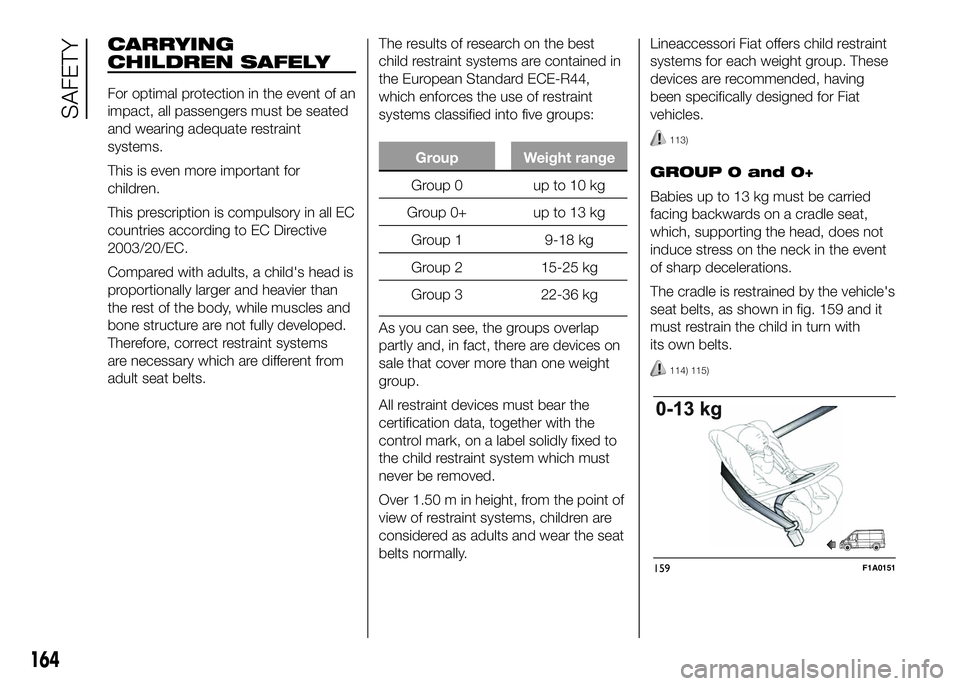
CARRYING
CHILDREN SAFELY
For optimal protection in the event of an
impact, all passengers must be seated
and wearing adequate restraint
systems.
This is even more important for
children.
This prescription is compulsory in all EC
countries according to EC Directive
2003/20/EC.
Compared with adults, a child's head is
proportionally larger and heavier than
the rest of the body, while muscles and
bone structure are not fully developed.
Therefore, correct restraint systems
are necessary which are different from
adult seat belts.The results of research on the best
child restraint systems are contained in
the European Standard ECE-R44,
which enforces the use of restraint
systems classified into five groups:
Group Weight range
Group0 upto10kg
Group 0+ up to 13 kg
Group 1 9-18 kg
Group 2 15-25 kg
Group 3 22-36 kg
As you can see, the groups overlap
partly and, in fact, there are devices on
sale that cover more than one weight
group.
All restraint devices must bear the
certification data, together with the
control mark, on a label solidly fixed to
the child restraint system which must
never be removed.
Over 1.50 m in height, from the point of
view of restraint systems, children are
considered as adults and wear the seat
belts normally.Lineaccessori Fiat offers child restraint
systems for each weight group. These
devices are recommended, having
been specifically designed for Fiat
vehicles.
113)
GROUP 0 and 0+
Babies up to 13 kg must be carried
facing backwards on a cradle seat,
which, supporting the head, does not
induce stress on the neck in the event
of sharp decelerations.
The cradle is restrained by the vehicle's
seat belts, as shown in fig. 159 and it
must restrain the child in turn with
its own belts.
114) 115)
159F1A0151
164
SAFETY
Page 169 of 387
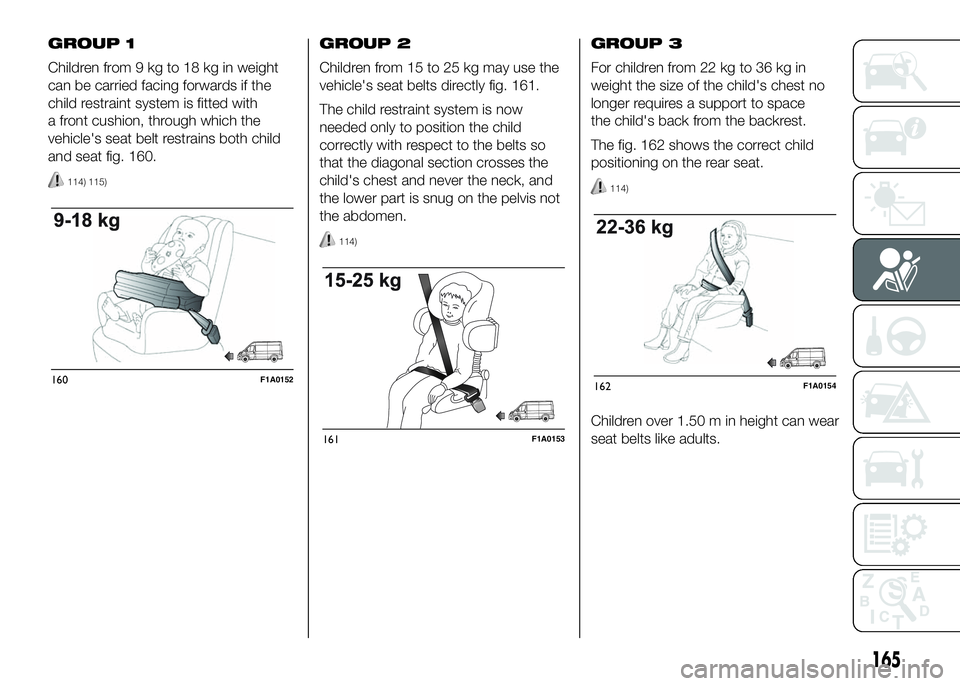
GROUP 1
Children from 9 kg to 18 kg in weight
can be carried facing forwards if the
child restraint system is fitted with
a front cushion, through which the
vehicle's seat belt restrains both child
and seat fig. 160.
114) 115)
GROUP 2
Children from 15 to 25 kg may use the
vehicle's seat belts directly fig. 161.
The child restraint system is now
needed only to position the child
correctly with respect to the belts so
that the diagonal section crosses the
child's chest and never the neck, and
the lower part is snug on the pelvis not
the abdomen.
114)
GROUP 3
For children from 22 kg to 36 kg in
weight the size of the child's chest no
longer requires a support to space
the child's back from the backrest.
The fig. 162 shows the correct child
positioning on the rear seat.
114)
Children over 1.50 m in height can wear
seat belts like adults.
160F1A0152
161F1A0153
162F1A0154
165
Page 171 of 387
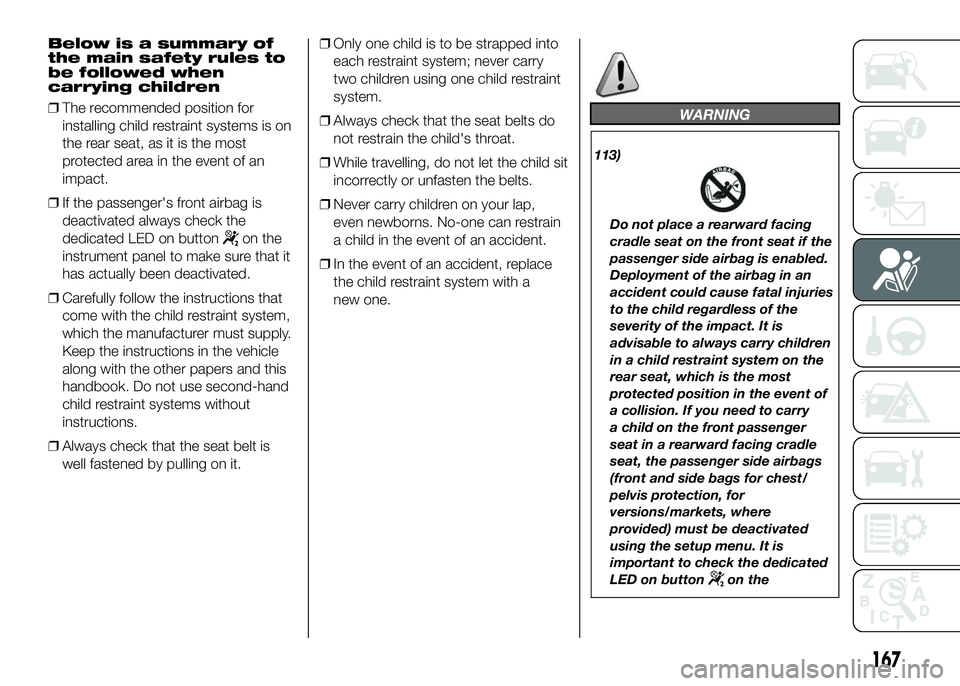
Below is a summary of
the main safety rules to
be followed when
carrying children
❒The recommended position for
installing child restraint systems is on
the rear seat, as it is the most
protected area in the event of an
impact.
❒If the passenger's front airbag is
deactivated always check the
dedicated LED on button
on the
instrument panel to make sure that it
has actually been deactivated.
❒Carefully follow the instructions that
come with the child restraint system,
which the manufacturer must supply.
Keep the instructions in the vehicle
along with the other papers and this
handbook. Do not use second-hand
child restraint systems without
instructions.
❒Always check that the seat belt is
well fastened by pulling on it.❒Only one child is to be strapped into
each restraint system; never carry
two children using one child restraint
system.
❒Always check that the seat belts do
not restrain the child's throat.
❒While travelling, do not let the child sit
incorrectly or unfasten the belts.
❒Never carry children on your lap,
even newborns. No-one can restrain
a child in the event of an accident.
❒In the event of an accident, replace
the child restraint system with a
new one.
WARNING
113)
Do not place a rearward facing
cradle seat on the front seat if the
passenger side airbag is enabled.
Deployment of the airbag in an
accident could cause fatal injuries
to the child regardless of the
severity of the impact. It is
advisable to always carry children
in a child restraint system on the
rear seat, which is the most
protected position in the event of
a collision. If you need to carry
a child on the front passenger
seat in a rearward facing cradle
seat, the passenger side airbags
(front and side bags for chest/
pelvis protection, for
versions/markets, where
provided) must be deactivated
using the setup menu. It is
important to check the dedicated
LED on button
on the
167
Page 172 of 387

instrument panel to make sure
that they are actually deactivated.
The passenger seat must also be
positioned back as far as possible
in order to avoid the child
restraint system from coming into
contact with the dashboard.
114) The figures are indicative and
for assembly purposes only. Fit
the child restraint system
according to the instructions,
which must be included.
115) Some child restraint systems
for weight group 0 and 1 have a
rear attachment to the car seat
belts and its own seat belts for
securing the child. Due to their
weight, they may be dangerous if
incorrectly mounted (e.g. if
fastened to the vehicle seat belts
placing a cushion in between).
Follow the assembly instructions
carefully.SETUP FOR
“UNIVERSAL
ISOFIX” CHILD
RESTRAINT SYSTEM
Provision has been made on the vehicle
to fit Universal Isofix child restraint
systems, a new European standardised
system for carrying children safely.
An example of a child restraint system
is shown in fig. 163.Due to its different attachment system,
the child restraint system must be
secured using the special lower metal
rings A fig. 164, positioned between
rear backrest and cushion. The upper
belt (provided with the child restraint
system) must be then secured to ring B
fig. 165 located in the lower part of
the seat. It is possible to have a mixed
assembly of traditional child restraint
systems and Universal Isofix ones.
163F1A0155164F1A0156
168
SAFETY
Page 175 of 387
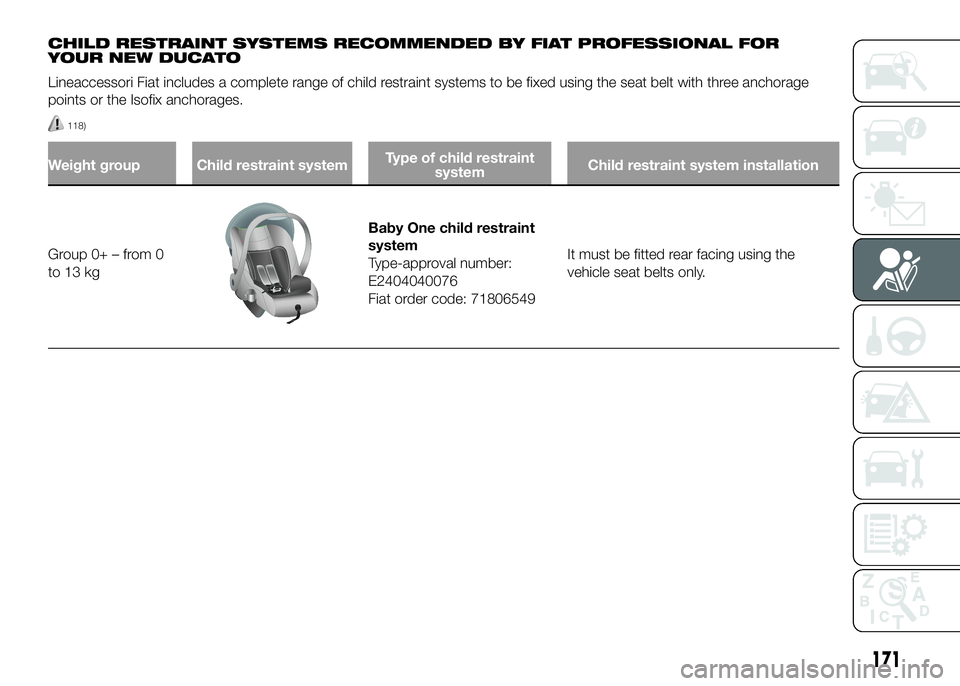
CHILD RESTRAINT SYSTEMS RECOMMENDED BY FIAT PROFESSIONAL FOR
YOUR NEW DUCATO
Lineaccessori Fiat includes a complete range of child restraint systems to be fixed using the seat belt with three anchorage
points or the Isofix anchorages.
118)
Weight group Child restraint systemType of child restraint
systemChild restraint system installation
Group 0+ – from 0
to13 kg
Baby One child restraint
system
Type-approval number:
E2404040076
Fiat order code: 71806549It must be fitted rear facing using the
vehicle seat belts only.
171
Page 176 of 387
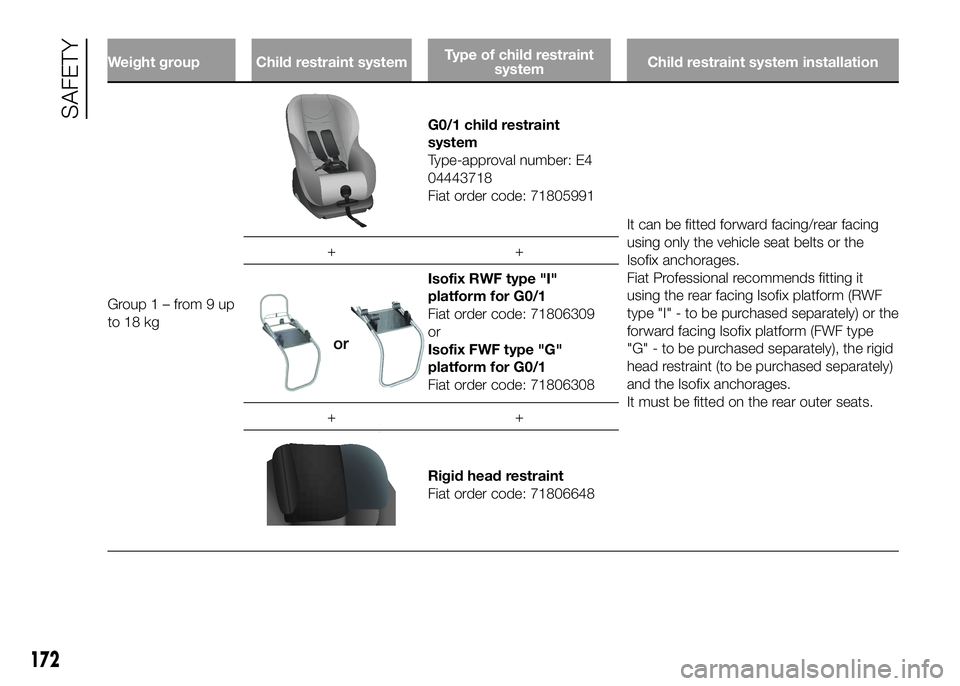
Weight group Child restraint systemType of child restraint
systemChild restraint system installation
Group1–from9up
to 18 kg
G0/1 child restraint
system
Type-approval number: E4
04443718
Fiat order code: 71805991
It can be fitted forward facing/rear facing
using only the vehicle seat belts or the
Isofix anchorages.
Fiat Professional recommends fitting it
using the rear facing Isofix platform (RWF
type "I" - to be purchased separately) or the
forward facing Isofix platform (FWF type
"G" - to be purchased separately), the rigid
head restraint (to be purchased separately)
and the Isofix anchorages.
It must be fitted on the rear outer seats. ++
Isofix RWF type "I"
platform for G0/1
Fiat order code: 71806309
or
Isofix FWF type "G"
platform for G0/1
Fiat order code: 71806308
++
Rigid head restraint
Fiat order code: 71806648
172
SAFETY
Page 177 of 387
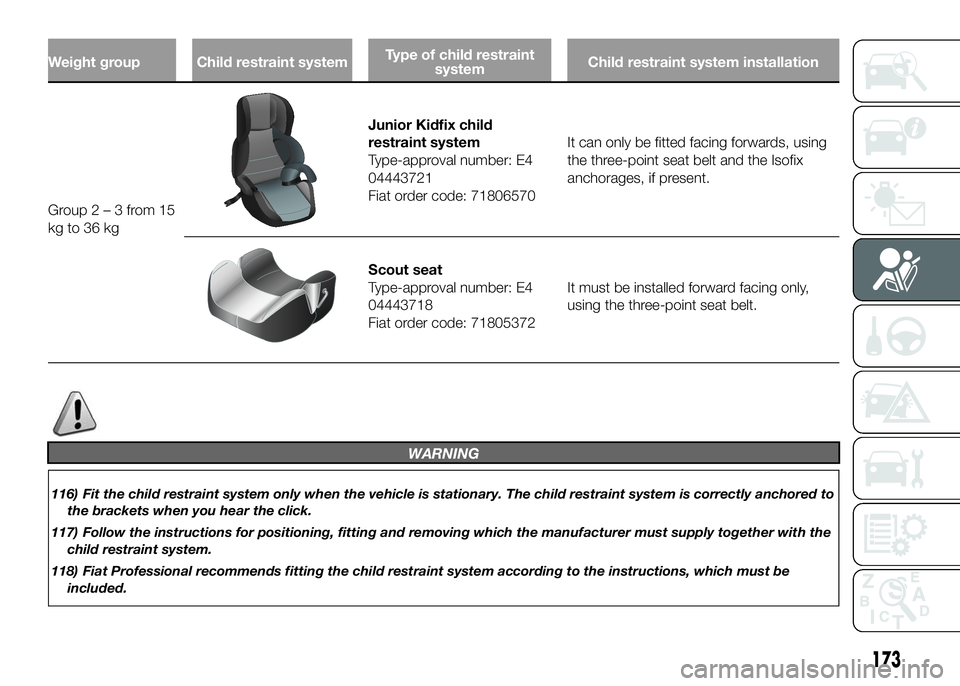
Weight group Child restraint systemType of child restraint
systemChild restraint system installation
Group2–3from15
kg
to 36 kg
Junior Kidfix child
restraint system
Type-approval number: E4
04443721
Fiat order code: 71806570It can only be fitted facing forwards, using
the three-point seat belt and the Isofix
anchorages, if present.
Scout seat
Type-approval number: E4
04443718
Fiat order code: 71805372It must be installed forward facing only,
using the three-point seat belt.
WARNING
116) Fit the child restraint system only when the vehicle is stationary. The child restraint system is correctly anchored to
the brackets when you hear the click.
117) Follow the instructions for positioning, fitting and removing which the manufacturer must supply together with the
child restraint system.
118) Fiat Professional recommends fitting the child restraint system according to the instructions, which must be
included.
173
Page 178 of 387
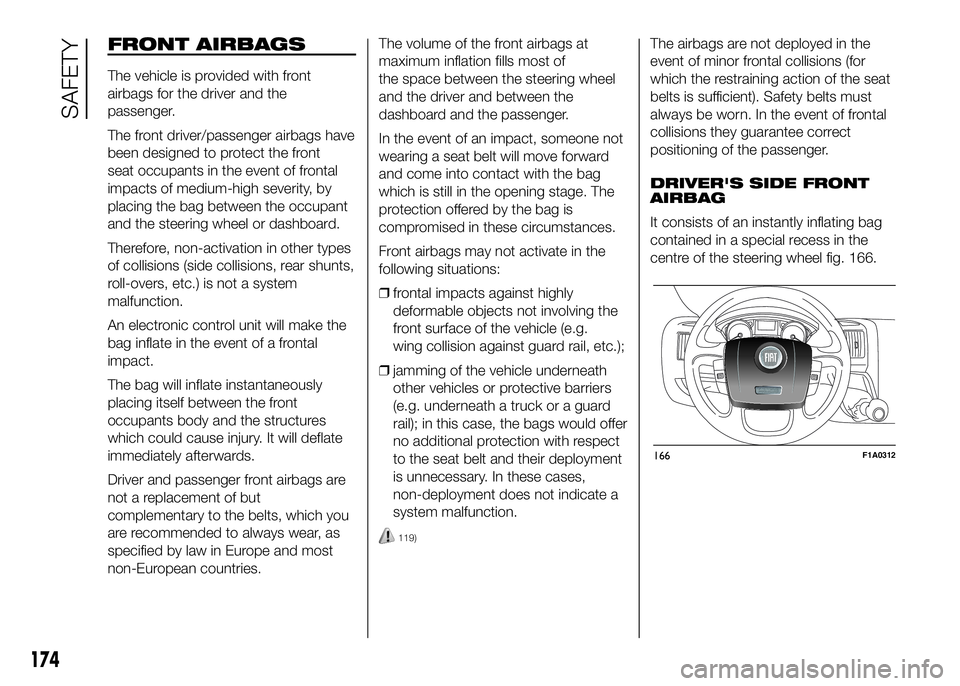
FRONT AIRBAGS
The vehicle is provided with front
airbags for the driver and the
passenger.
The front driver/passenger airbags have
been designed to protect the front
seat occupants in the event of frontal
impacts of medium-high severity, by
placing the bag between the occupant
and the steering wheel or dashboard.
Therefore, non-activation in other types
of collisions (side collisions, rear shunts,
roll-overs, etc.) is not a system
malfunction.
An electronic control unit will make the
bag inflate in the event of a frontal
impact.
The bag will inflate instantaneously
placing itself between the front
occupants body and the structures
which could cause injury. It will deflate
immediately afterwards.
Driver and passenger front airbags are
not a replacement of but
complementary to the belts, which you
are recommended to always wear, as
specified by law in Europe and most
non-European countries.The volume of the front airbags at
maximum inflation fills most of
the space between the steering wheel
and the driver and between the
dashboard and the passenger.
In the event of an impact, someone not
wearing a seat belt will move forward
and come into contact with the bag
which is still in the opening stage. The
protection offered by the bag is
compromised in these circumstances.
Front airbags may not activate in the
following situations:
❒frontal impacts against highly
deformable objects not involving the
front surface of the vehicle (e.g.
wing collision against guard rail, etc.);
❒jamming of the vehicle underneath
other vehicles or protective barriers
(e.g. underneath a truck or a guard
rail); in this case, the bags would offer
no additional protection with respect
to the seat belt and their deployment
is unnecessary. In these cases,
non-deployment does not indicate a
system malfunction.
119)
The airbags are not deployed in the
event of minor frontal collisions (for
which the restraining action of the seat
belts is sufficient). Safety belts must
always be worn. In the event of frontal
collisions they guarantee correct
positioning of the passenger.
DRIVER'S SIDE FRONT
AIRBAG
It consists of an instantly inflating bag
contained in a special recess in the
centre of the steering wheel fig. 166.
166F1A0312
174
SAFETY
Page 183 of 387
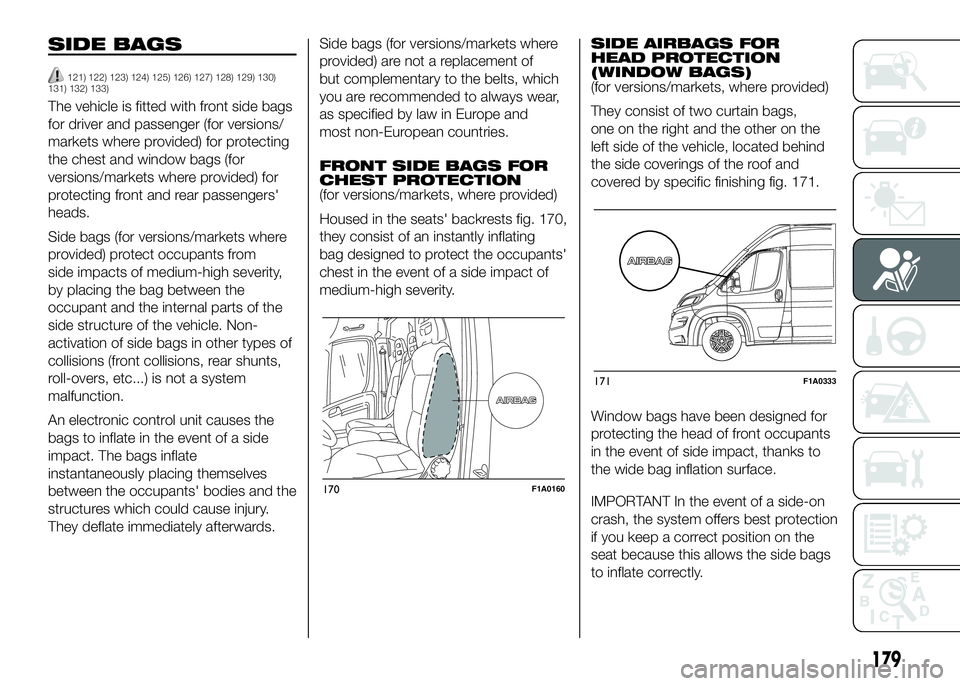
SIDE BAGS
121) 122) 123) 124) 125) 126) 127) 128) 129) 130)
131) 132) 133)
The vehicle is fitted with front side bags
for driver and passenger (for versions/
markets where provided) for protecting
the chest and window bags (for
versions/markets where provided) for
protecting front and rear passengers'
heads.
Side bags (for versions/markets where
provided) protect occupants from
side impacts of medium-high severity,
by placing the bag between the
occupant and the internal parts of the
side structure of the vehicle. Non-
activation of side bags in other types of
collisions (front collisions, rear shunts,
roll-overs, etc...) is not a system
malfunction.
An electronic control unit causes the
bags to inflate in the event of a side
impact. The bags inflate
instantaneously placing themselves
between the occupants' bodies and the
structures which could cause injury.
They deflate immediately afterwards.Side bags (for versions/markets where
provided) are not a replacement of
but complementary to the belts, which
you are recommended to always wear,
as specified by law in Europe and
most non-European countries.
FRONT SIDE BAGS FOR
CHEST PROTECTION
(for versions/markets, where provided)
Housed in the seats' backrests fig. 170,
they consist of an instantly inflating
bag designed to protect the occupants'
chest in the event of a side impact of
medium-high severity.SIDE AIRBAGS FOR
HEAD PROTECTION
(WINDOW BAGS)
(for versions/markets, where provided)
They consist of two curtain bags,
one on the right and the other on the
left side of the vehicle, located behind
the side coverings of the roof and
covered by specific finishing fig. 171.
Window bags have been designed for
protecting the head of front occupants
in the event of side impact, thanks to
the wide bag inflation surface.
IMPORTANT In the event of a side-on
crash, the system offers best protection
if you keep a correct position on the
seat because this allows the side bags
to inflate correctly.
170F1A0160
171F1A0333
179